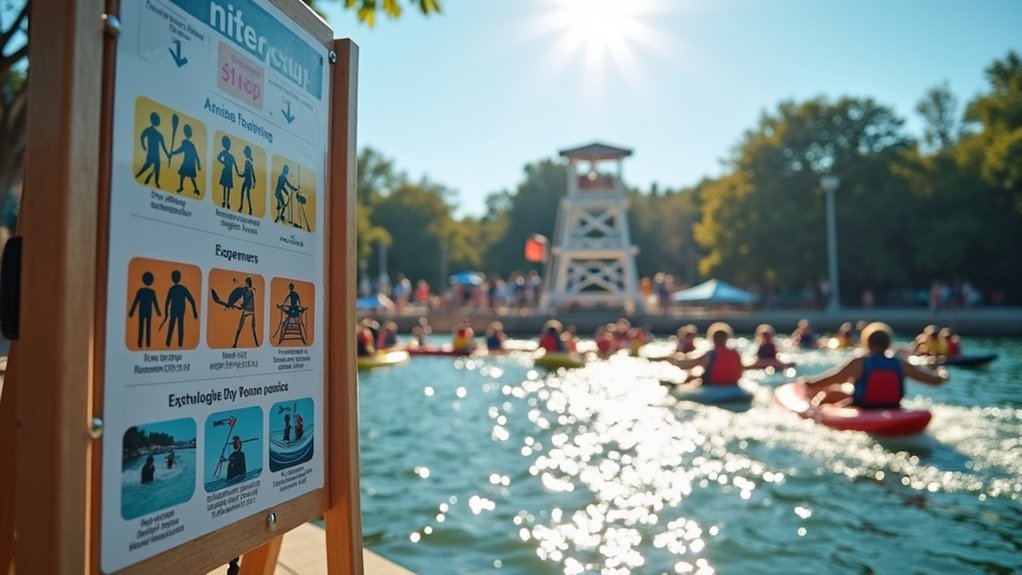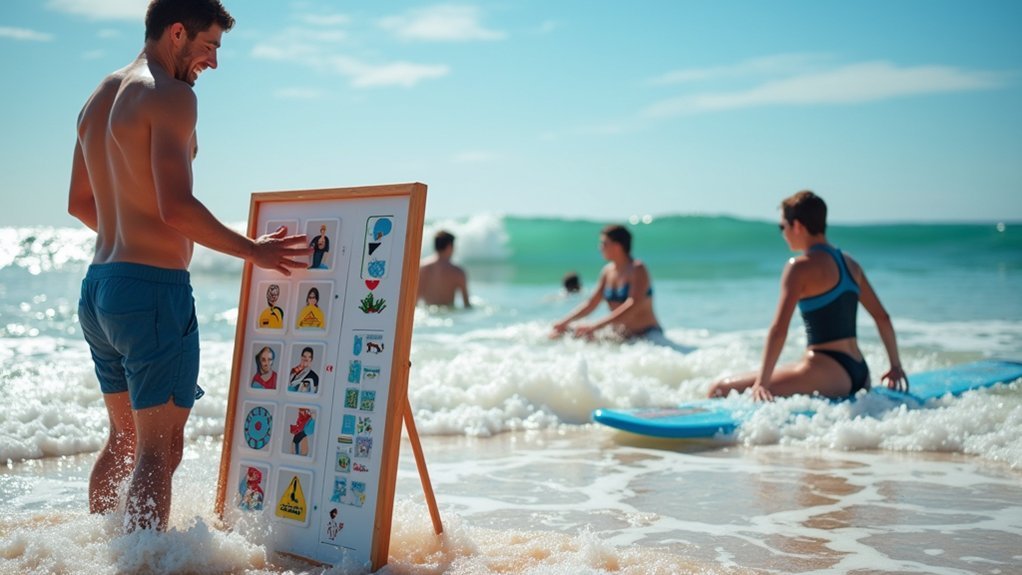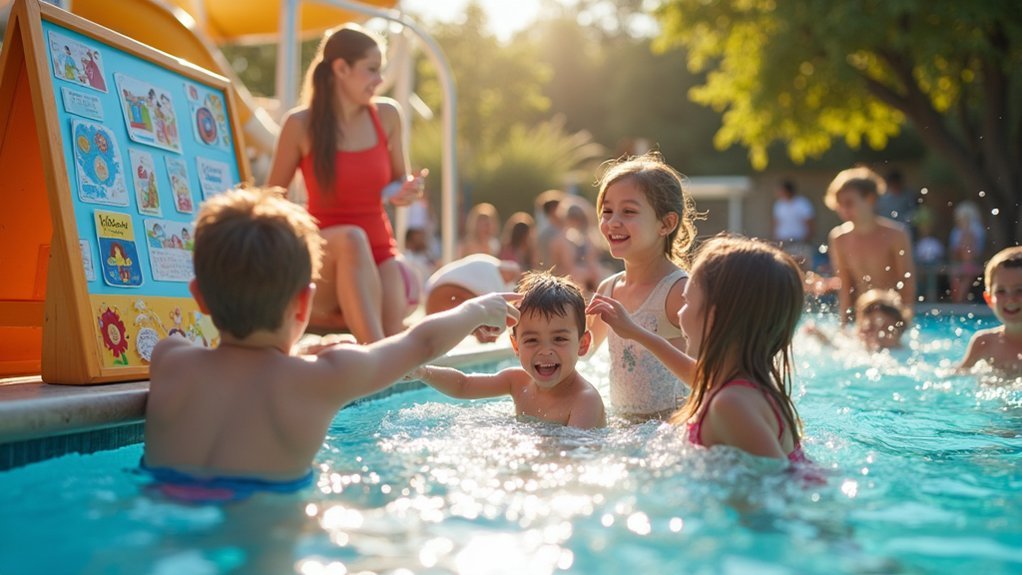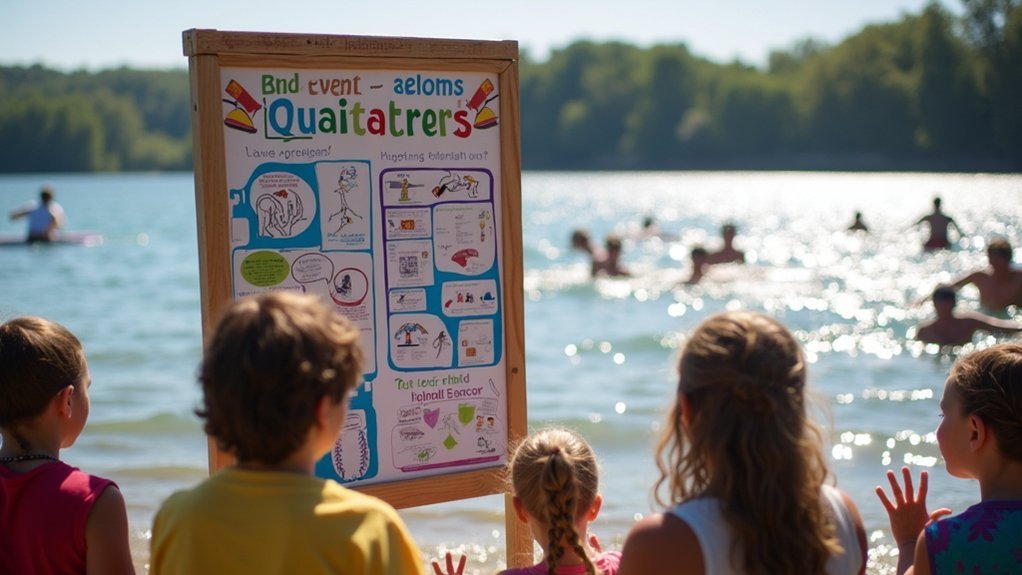Communication boards are essential in water sports because they bridge gaps for non-verbal athletes, enhancing safety in noisy aquatic environments. You’ll find these waterproof tools enable quick expression of urgent needs like “Help” or “I need a break,” allowing lifeguards to respond promptly. They empower athletes with confidence, independence, and fuller participation in swimming activities. Made from durable materials with specialized symbols, these visual aids transform passive observation into active engagement while creating more inclusive water experiences.
Enhancing Safety Through Visual Communication in Aquatic Environments

While the splashing and laughter at waterparks create an atmosphere of joy, they also present unique communication challenges that can compromise safety for children with speech differences.
You’ll find that waterproof communication boards serve as critical visual tools that bridge this gap in aquatic environments. These boards enable non-verbal children to express urgent needs like “Help” or “I need a break” through universally recognized symbols.
In crowded, noisy pool areas, where verbal communication often fails, these visual aids guarantee children can effectively articulate discomfort or distress. Lifeguards and staff can quickly understand and respond to these visual cues, greatly reducing the risk of miscommunication during emergencies.
Breaking Barriers: How Communication Boards Support Non-Verbal Athletes
Communication boards break down critical barriers for non-verbal athletes, giving you the tools to express immediate needs and emotions in water environments.
You’ll notice enhanced safety through visual cues that allow quick communication of urgent messages like “I need help” or “I’m tired,” preventing potential incidents before they occur.
Your confidence grows as you gain control over your aquatic experience, enabling fuller participation and creating meaningful connections with coaches and teammates.
Empowering Silent Voices
For athletes who cannot express themselves verbally, water sports often present unique challenges that extend beyond the physical demands of the activity. Communication boards transform this experience by empowering non-verbal participants to clearly express their needs during water activities.
| Communication Need | Board Symbol | Impact |
|---|---|---|
| Safety Concerns | “Help” icon | Immediate assistance when needed |
| Physical Needs | “Break” symbol | Prevents exhaustion and anxiety |
| Emotional Expression | Emotion faces | Creates inclusive and engaging experience |
You’ll notice how these visual tools reduce overwhelming feelings in noisy aquatic environments while promoting independence. With specific vocabulary related to water sports, athletes gain confidence and control over their participation. By implementing these customizable boards in your facility, you’re not just enabling communication—you’re fostering dignity and self-expression for every athlete in the water.
Visual Cues Enhance Safety
Safety becomes the ultimate priority when non-verbal athletes engage in water sports. Communication boards with clear visual cues provide an essential lifeline, enabling these athletes to express urgent needs without spoken words. When you’re coaching or supporting non-verbal participants, these waterproof tools allow them to quickly communicate messages like “Help,” “I need a break,” or concerns about water temperature—potentially preventing dangerous situations.
You’ll notice these athletes experience notably greater comfort in noisy, crowded aquatic environments when equipped with effective communication tools. The visual symbols reduce misunderstandings that could compromise safety, creating a more secure experience for everyone involved.
Building Confidence Through Communication
When non-verbal athletes discover their voice through specialized communication boards, a remarkable transformation in confidence often follows.
You’ll notice how these tools empower participants to express their thoughts and make choices during water activities, fostering independence that might otherwise remain untapped.
Communication boards featuring relevant aquatic symbols create an inclusive and supportive environment where non-verbal athletes can actively participate rather than passively observe.
This ability to communicate reduces anxiety in busy pool settings and enhances enjoyment of swimming and water sports.
Waterproof Design Features for Effective Pool-Side Communication
Three essential design features make waterproof communication boards indispensable for pool-side environments.
First, they’re constructed from high-quality materials like 3mm aluminum or 6MM PVC, guaranteeing they remain durable and functional despite constant water exposure. These waterproof communication boards withstand splashing and humidity while maintaining structural integrity.
Second, eco-friendly UV ink technology prevents color fading, preserving visual clarity for 5+ years with proper maintenance. You’ll appreciate how these visual tools retain their vibrancy even in harsh sunlight and chlorinated environments.
Finally, customizable options allow you to tailor symbols and vocabulary to specific waterpark activities, enhancing user understanding. This flexibility guarantees guests with communication challenges can effectively express needs and preferences during aquatic experiences, making water sports more accessible and enjoyable for everyone.
The Impact of Visual Aids on Confidence and Participation Levels

Visual communication boards break invisible barriers for non-verbal children, transforming water activities from anxiety-producing experiences to ones filled with joy and accomplishment.
You’ll notice your child moving beyond fear as they gain the confidence to express needs like “I need a break” or request help during aquatic play.
Parents consistently report significant progress in their children’s willingness to participate in water sports when equipped with these essential tools that promote independence and peer interaction.
Breaking Invisible Barriers
For children with communication challenges, the underwater world often remains tantalizingly out of reach, not because of physical limitations, but due to invisible barriers of expression.
Communication boards shatter these barriers by creating bridges between non-verbal children and their water activities environment.
You’ll notice how these visual aids transform special needs participation into truly inclusive experiences. When your child can express their emotions, needs, and choices during swimming or boating, they’re no longer passive participants—they become active explorers.
The impact extends beyond basic needs; these tools foster meaningful social interactions as children can share excitement, concerns, and discoveries with peers and instructors.
Beyond Fear, Toward Fun
When water environments overwhelm children with communication challenges, visual aids provide a powerful pathway from apprehension to enjoyment. Communication boards empower your non-verbal child to express emotions and needs in crowded pools and waterparks, considerably reducing their anxiety.
You’ll notice how these tools transform water activities from stressful to enjoyable experiences. Research shows children using these boards develop higher confidence levels during social interactions. By helping them manage overwhelming feelings, you’re enabling them to navigate aquatic spaces with greater comfort.
These visual aids don’t just support individual needs—they create opportunities for meaningful peer interactions. As your child communicates more effectively, they’ll experience a deeper sense of belonging and inclusivity.
The result? Water sports become accessible, social, and fun for everyone, regardless of communication differences.
Parents See Progress
The transformation in children’s confidence becomes strikingly apparent to parents once communication boards enter the water recreation equation.
You’ll notice your non-verbal child initiating social interactions they previously avoided, making choices about which slides or pools they want to explore next.
Parents consistently report that these visual aids reduce overwhelm in busy aquatic environments, allowing children to focus on enjoyment rather than anxiety.
Your child’s newfound ability to express needs and feelings translates into more meaningful participation in water activities.
Beyond simple communication, these boards foster independence and decision-making skills that extend well beyond the water park.
You’ll appreciate how these tools enhance family outings, creating positive experiences for everyone involved.
The progress you’ll witness isn’t just about better communication—it’s about watching your child thrive.
Creating Inclusive Waterparks: Success Stories and Implementation

Waterparks across the country are transforming into more inclusive spaces through the strategic implementation of communication boards.
Collaborations between facilities like Overland Park and organizations such as Smarty Symbols have yielded water-resistant, customized communication boards specifically designed for aquatic settings.
You’ll find these innovative tools helping non-verbal children and those on the autism spectrum effectively express their needs while enjoying water activities. Families report significant improvements in their overall experience, as these boards provide children with an enhanced sense of safety and security in busy environments.
Community-driven installations have succeeded in numerous waterparks, fostering environments where children engage with greater independence.
The essential water-activity vocabulary featured on these boards guarantees clear communication, making water sports facilities genuinely inclusive for all guests regardless of communication abilities.
From Swimming Lessons to Competitive Sports: Versatility of Communication Boards
Communication boards stretch far beyond waterpark settings into structured aquatic learning environments and competitive arenas.
You’ll find these tools bridging gaps for non-verbal participants across the swimming spectrum—from beginners expressing “I need a break” during lessons to elite athletes communicating strategy during competitions.
The versatility of customizable communication boards enhances water sports through:
- Safety empowerment – Providing immediate ways to signal for help or express discomfort in potentially dangerous aquatic environments
- Team cohesion – Enabling all athletes to contribute ideas during relays or training sessions, regardless of speech abilities
- Personal growth – Boosting self-confidence as swimmers experience the freedom of clear expression without verbal barriers
This inclusivity transforms water sports into truly accessible activities where effective communication flows as freely as water itself.
Empowering Independence: Self-Expression in Water Activities
When individuals struggle to communicate verbally, water environments can amplify their challenges, yet well-designed communication boards transform this dynamic entirely. These tools empower non-verbal participants to express needs, preferences, and feelings like “happy” or “overwhelmed” during water activities.
You’ll notice how waterproof communication boards enhance safety by allowing users to request assistance or indicate when they need a break in busy aquatic settings. By facilitating independent decision-making, these boards give individuals control over their experience, leading to more fulfilling participation.
The key to maximizing effectiveness lies in customizable options that reflect specific vocabulary relevant to each water environment. Through self-expression in water activities, communication boards don’t just facilitate conversation—they build confidence, foster independence, and create more inclusive aquatic experiences for everyone.
Practical Applications for Coaches and Instructors in Aquatic Settings
While teaching in aquatic environments presents unique challenges, communication boards offer practical solutions that transform how coaches and instructors interact with non-verbal participants. As an essential tool in special education settings, they’re particularly valuable during water activities where verbal instructions can be difficult to convey.
- Create customizable boards with water-specific vocabulary to help non-verbal children request breaks, assistance, or equipment during lessons.
- Develop inclusive learning experiences by using visual cues that allow all children to follow multi-step instructions for swimming techniques.
- Establish safety protocols using visual communication systems that work effectively even in noisy pool environments.
You’ll find these boards bridge communication gaps, ensuring every child can participate fully while building confidence and independence in aquatic skills.
The Evolution of Adaptive Equipment in Recreational Water Sports
The world of adaptive water sports equipment has undergone remarkable transformation in recent decades, extending far beyond the communication tools used by instructors.
You’ll notice specialized life jackets, seated kayaks, and adaptive water skis now enable individuals with mobility challenges to participate fully in water activities they once couldn’t access.
Communication boards have revolutionized the experience for non-verbal participants, allowing them to express needs and emotions during aquatic adventures.
Today’s waterproof communication tools function effectively even in noisy, busy water environments.
What’s particularly encouraging is the collaborative approach between designers, therapists, and recreational facilities, creating truly inclusive aquatic experiences.
This evolution isn’t just about accessibility—it’s about fostering community and ensuring everyone belongs in the water, regardless of their physical capabilities.
Frequently Asked Questions
Why Is the Communication Board Important?
Communication boards are important because they help you express your needs when you can’t speak. They’ll reduce your frustration, increase your independence, and let you participate fully in activities despite communication challenges.
What Should Be Included in a Communication Board?
Your communication board should include water-related vocabulary, symbols, emergency phrases, emotions, and needs. It’s important to use color-coding, waterproof materials, and prompts that encourage pointing while speaking for effective interaction.
Who Needs a Communication Board?
You’ll need a communication board if you’re non-verbal, have autism, speech differences, or limited language abilities. They’re also helpful if you’re overwhelmed in loud environments or need visual support for expression.
How to Use Communication Boards Effectively?
To use communication boards effectively, point to symbols while speaking, encourage users to do the same, verbalize meanings, place boards strategically, and maintain them regularly. You’ll create an inclusive environment for all communication needs.
In Summary
You’ve seen how communication boards transform water sports from exclusive to inclusive environments. They’re not just tools—they’re gateways to independence, safety, and confidence for athletes of all abilities. By embracing these visual aids in your aquatic programs, you’ll break communication barriers and create opportunities for everyone to experience the joy of water sports. Don’t wait—make your pool a place where everyone belongs.





Leave a Reply